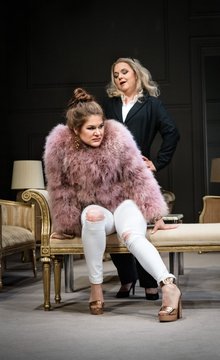TARTUFFE
STAFFAN VALDEMAR HOLMS TARTUFFE AT DRAMATEN IN STOCKHOLM
Even though I don’t speak Swedish I want to see performances all around Stockholm during my exchange semester at Stockholm University. The first critics I’m writing for Teateristan happens to be about Staffan Valdemar Holms Tartuffe at Dramaten.
So what happens when a non-native speaker sees a performance in a local theatre? Luckily I knew the plot. Without this knowledge it would have been hard to understand the story, as some parts in Holms performance are heavily based on the text, for example in the beginning when Orgon, the family father, has a conversation with his brother Cléante. Throughout the performance character Orgon seems to be the weakest, played by Magnus Roosmann. Roosmann is not waiting for impulses or reactions from his actor colleagues but just plays over it. He’s not acting together but for himself, just to get over it.
This impression is certainly based as well on the contrast between the corporality of other characters and the one Orgon hasn’t. As I didn’t understand the language, I focused on the next most important thing on stage: the body and its movements. While the character Orgon behaved more stiff and flat, his daughter Mariane behaved childish but very comical. Emma Broomé, who played Mariane, focused on an over the top style in acting a luxurious, spoiled brat, based on childish mimicry and “bitchy” movements.
The costume looked like many women and girls in Stockholm are wearing right now: tight white trousers with holes; highheels, which made her legs look like the ones of an antelope; and a fake fur jacket in altrose, the same colour her partner Valère and the mother Elmire are wearing.
As the minimalistic scenography on stage is hold in style of a modern hotel lobby, the movements of each body appear bigger and rightly so take up space. This is why the longer dialogues without much movement were nice as a contrast but still took too long. Acting happened seldom in the back of the stage, but mostly in front. Mariane moves and behaves stereotypically as a papas darling daughter, she probably gets everything she wants except this one time, when her father decides to wed her to Tartuffe.
As the ensemble shows a wealthy, modern 21-century family, which could be a Swedish one, it’s not credible to have a marriage organised by the father. However Mariane's reactions let us forget about it. First she is shocked, cries out loud for one time, freezes in sadness and then she throws herself to the ground, rolls around, cries, screams, makes a break and starts again. All of that happens in an artistic way I havent seen for long time. Broomé finds the perfect balance of overcasting and screaming. She is not only showing a stereotype of a "rich-bitch" but more a huge expression of suffering in a funny way.
The performance moves on to the meeting of her and Valère, where we see a hilarious breakup scene. That's how I expect Swedish stereotypical trendsetters to behave. I don’t believe they really love each other, Valère just happens to be the perfect son in law, looking as many of them do. One could pick these two characters sitting in Stockholm subway. As they argue on stage it’s more like kids fighting: childish insults, putting the tongue out and so on. The only more or less down to earth character is Dorine, who manages to put the couple together again. Also Dorines movements and characterisation happen to be more different to Orgons. She moves fast and runs all the time. She’s the only one, who has the overview about Tartuffes machinations.
All the others mostly concentrate on their own business and don’t think about each other. Son Damis tries to convince his father about Tartuffes bad side, but his shouting has no effect. The mother is seducing Tartuffe really strongly until Orgon believes the family. Only Tartuffe seems to be the only one, who doesn't do actively something for the ruin of the family, they do it themselves.
Not even in the end they help each other and Mariane is left by everybody in Tartuffes hand as they leave the house. The ending is different than Molières classic one, where the king saves the people. In Holms performance, the wealthy ones lose and have to leave, while homeless men inhabit the house.
Saima Sägesser
PRENUMERERA
PÅ VÅRT NYHETSBREV
För senaste nytt inom Stockholms teatervärld.
